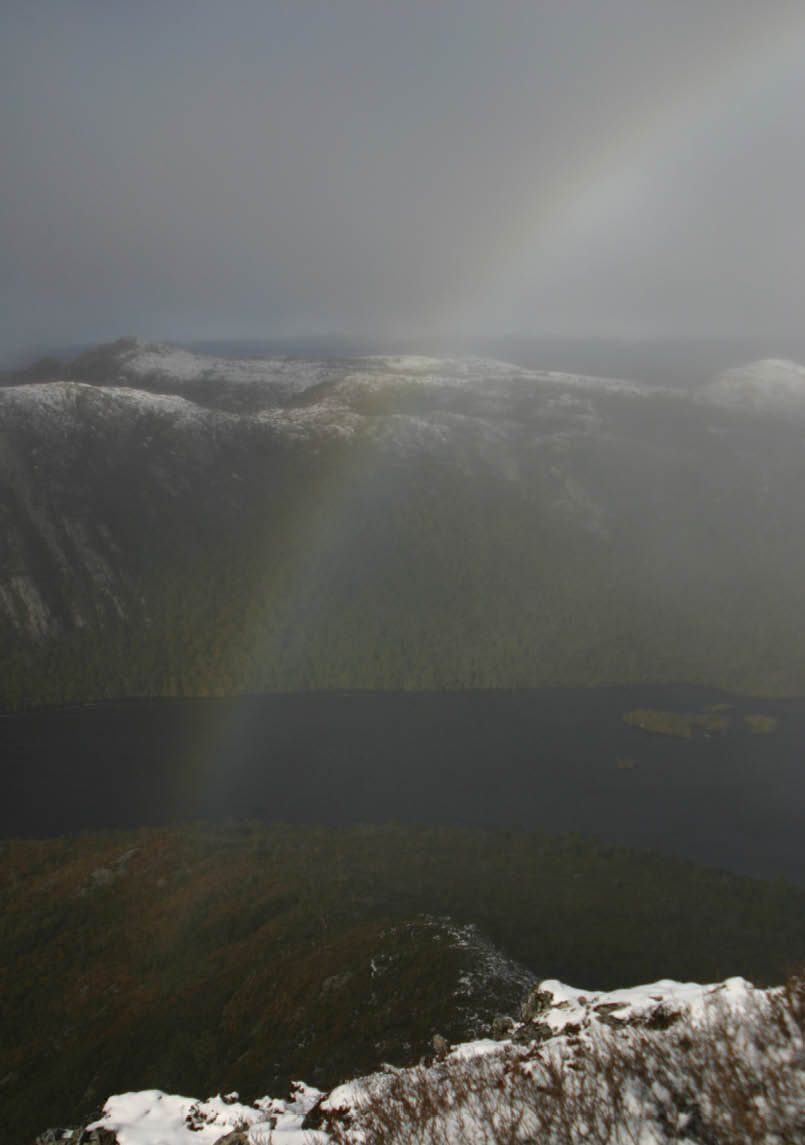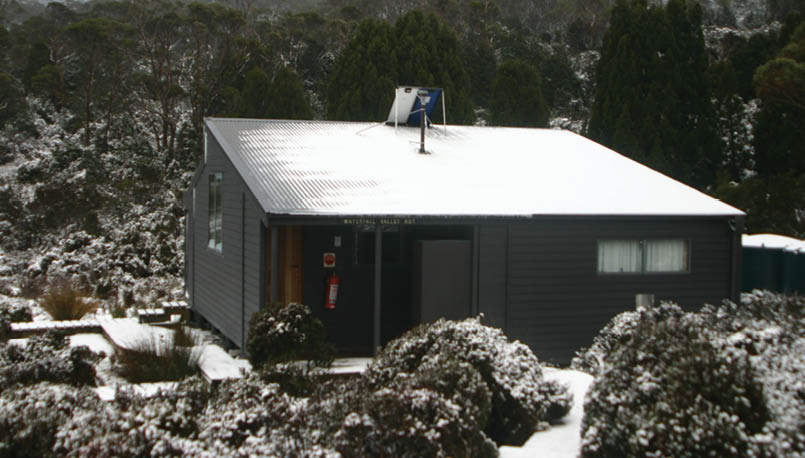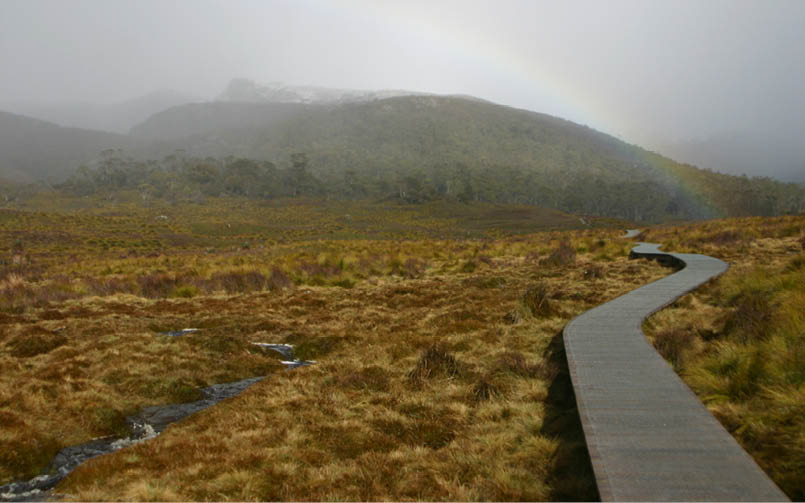


Should we prevent unprepared people entering wild places?
This article is based around a tragic event, one that is not unique but that has sadly impacted on the lives of all those involved and who loved Kang Jin. Kang Jin (21) was from Gansu in China and studying at Deakin University in Victoria. He died in 2014 of hypothermia on Tasmania's Overland Track while walking with two friends.
Rainbow over Dove Lake

Should They Be Stopped?
Matt McClelland

58 | BWA June 2017





“I recommend that PWS ... prevent persons embarking on the Overland Track walk when they are observed to be inadequately prepared for the conditions such as to place the safety of themselves and others at risk.” Olivia McTaggart, Coroner.
It is easy to point the finger and say that this was a clear run of errors and a death that could have been so easily avoided. However, I would like to take pause, sit back and think about what we can do better, primarily:
I hope that we can better understanding of how quickly things can go bad.
I hope we can appreciate the heroic efforts of other bushwalkers involved.
I hope we can better understand the issues that language and cultural barriers present.
I hope that we can come up with good ways to care for novice bushwalkers.
Let's start with a few quotes from the Coroner's findings to set the scene.
“In February 2014 Bojie Yang and her housemate, Lianguan Yu, decided to walk the full length of the Overland Track at Cradle Mountain. They invited Kang Jin. As described further, their preparation was inadequate for the walk.“
“On 20 February 2014, the weather conditions were very poor. It was cold, rainy and windy. The wind was increasing in strength, and was expected to further increase as the day went on. The weather was colder than normal for the month of February, and the conditions were challenging for walkers. At 11.45am the group approached the counter at the Visitor Centre and spoke to Mr Gregory Wall, the supervisor. Mr Wall noticed that the group were carrying 30 litre packs contrary to the common practice to carry a 60 litre pack when walking the Overland Track. The group were wearing light clothing and were asked by Mr Wall if they had a change of clothing, including waterproof pants. The group were informed the weather was going to get colder, and they nodded their heads that they understood”.
“Mr Wall asked the group if they had tents, to which Bojie Yang replied that she had a tent for three people. The group was asked if they had sleeping bags and if they were prepared for cold weather. Bojie Yang replied "yes" and Kang Jin and Lianguan Yu nodded their heads. Mr Wall was concerned that the group were not properly prepared and asked the same questions three times. He spent approximately 30 minutes with them before passing them over to Gail Oliver, a customer service officer at the Visitor Centre.”
Waterfall Valley Hut
BWA June 2017 | 59


“Kang Jin, Lianguan Yu and Bojie Yang were obviously ill-equipped for the walk. Their food supplies and clothing were inadequate. Kang Jin was wearing a thin spray jacket (purchased just prior to the walk at the Visitors Centre), a blue and black windcheater, a cotton shirt, a pair of tan trousers over boxer shorts, and open black sandals. His clothing was wet through to the skin at the time the rescue party reached him.”
The trio did not have enough experience to know what they did not know. They seem to underestimate how the weather will impact their bodies, gear and clothing. They seem to not appreciate the need for more appropriate clothing and footwear to protect them from the weather. There are little details about what else they were carrying, but it seems reasonable to assume that their food, cooking gear and shelter were also unsuitable for the conditions.
In the last five-ish years the number of people bushwalking in Australia has nearly doubled. That's a lot more people out and exploring amazing places. At the same time
we have access to an incredible amount of information online about walks, gear, waterproofs, reviews, gear lists, weather, bushwalking technology and much more.
I think there are two major things missing from this online experience.
1 WisdomIn a world where the Bear Grylls-type experience is promoted as fun and adventurous, I suspect people lack the insight to distinguish between what looks like fun on television and what is actually a positive experience in real life. Seeing someone surviving in crazy situations on the small screen it's too easy for many people to assume that they can survive as well. There are many blogs and television shows that seem to be based on the idea of preparing to survive extremes or even benign wild areas rather than preparing to have an enjoyable and safe time with suitable gear, experience and fitness.
2 PromotionToo much effort from parks agencies is spent in promoting the ultimate “experience” rather than equipping people for the journey. Somewhat ironically I think, the Tasmanian Parks and Wildlife Service (PWS) are better at
Overland Track near Ronny Creek
“The trio did not have enough experience to know what they did not know.
60 | BWA June 2017

equipping people than most other agencies around Australia. Promotion should be more educational, setting reasonable expectations and providing the resources to help people be better equipped to undertake the walk.
We know that walks like the Overland Track attract people from around the world, so we need to ask questions about how we deal with language and cultural differences. Language differences are somewhat easy to deal with and are addressed in the Coroner's report; cultural differences are much harder.
One example of a cultural difference we see is with European tea houses. In parts of Europe (and China) you can go on many popular walks with the reasonable expectation to come across a tea house for lunch or overnight stay. If the weather turns there is shelter, warmth and food. I've met people near the top of Mount Kosciuszko looking for a nearby tea house - there are none. It's understandable that people come to Australia expecting one thing but not finding it. A challenge we have in Australia is to know what these expectations might be and pro-actively help people understand our unique environment.
Another example is the use of the terms “bad” or “cold” weather. While every region has “bad” and “cold” weather, what is bad weather in one part of the world is different to another and what gear and experience are needed to deal with those different conditions also varies. People may be used to high winds in warmer conditions. Another I have seen is that people used to very cold conditions in North America can struggle in Australian near-zero temperatures where snow and ice melt and make your clothes wet rather than just brushing off much colder snow.
I also do not want to suggest that this is a cultural issue alone; people come unstuck and die on bushwalks for many different reasons. I think that this cultural issue is not considered enough when promoting walks. I know I do not do enough to deal with it either.
Walks like the Overland Track are always going to be promoted with the big blue sky images, with beautiful people dancing along the track. The challenge is how to better communicate the real difficulty walks like this can present and how to better prepare. Following this specific incident, I think PWS are making some great moves to address many of these issues and better equip people for their walks. In fact I think PWS have been leading the way in pro-actively equipping and welcoming visitors to iconic walks for a long time.
In no way do I wish to criticise the work of PWS or the Coroner in this case. I simply wish to explore the idea of doing things differently so we can all enjoy wild places more and more.
Is regulation the answer?The main question I would like to raise is from the first recommendation from the Coroner in this case.
“I recommend that PWS give consideration to the availability and use of legislative powers, and consequent development of procedures, to prevent persons embarking on the Overland Track walk when they are observed to be inadequately prepared for the conditions such as to place the safety of themselves and others at risk.”
On the surface this seems like a good idea, especially in light of this party who were so clearly ill-prepared for the journey.
There are many challenges when giving staff the ability to ban walkers, mainly that it is so hard to make a reliable call if someone is adequately prepared for a specific journey. In favourable weather conditions, someone with excellent bushcraft skills can undertake a journey like this with very little gear. Equally, someone with enough money can buy a lot of gear at a bushwalking store, walking out with very fancy gear, but have no idea how to use it and come unstuck very quickly. Fitness, stamina and judgement may be low or nil for such people.
“The challenge is how to better communicate the real challenges walks like this can present and how to better prepare.
“... what is bad weather in one part of the world is different to another ...
BWA June 2017 | 61


Preparedness is not a simple spectrum, with the well prepared at one end and poorly prepared at the other. If this was the case then we could draw a line in the spectrum and say this this is the preparedness level required. Preparedness is a web with an infinite number of elements and levels. There is no place to draw a line.
Using general gut feeling and experience we could all fairly easily pick people who are very unprepared and those who are very well prepared. The challenge is with the masses in the middle where it is much harder to make a judgement call. If the party considered by this inquiry set off a few days later then they probably would have enjoyed the walk, perhaps eating other walker's leftovers, and with some cold nights.
A few years back I met a solo walker near the end of the Overland Track in mid-winter. He was walking in jeans, a cotton jumper and gum boots with very stinky nylon socks. He was the only other person we had seen for six days. He started the walk with two dozen hard boiled eggs and some tea. If I saw him at the start I would have advised him that he was very poorly equipped for the journey, but I met him on his second-last night and he seemed to be fit and well. Some people get away with bushwalking with very different gear from what I am comfortable with. If the snow was deeper, or the weather was colder it may have been very different, but I do not know.
Requiring land management staff to make a call on who is and is not adequately equipped seems very troublesome to me. Practically, it is very difficult to implement a policy on how to make the decision. There's a big difference between preventing someone undertaking a walk and suggesting that they change plans to something else. Policies have the trouble of drawing lines in the sand in very fuzzy areas. People can end up setting limits on specific ages, fitness, (dis)ability, specific equipment or formal training. It is much harder to make the decision in areas that are more likely to predict safety such as wisdom, experience and preparedness. Actually the thing is, there is very little research I can find that gives us any guidance on what attributes do actually predict safe (and enjoyable) journeys.
Part of the Coroner's role is to make recommendations that will reduce the chance of a similar death in the future. I greatly respect the role of Coroners and the difficult job they have.
We readily accept licensing and bans when we think about cars. Licensing and other controls exist for recreational pursuits such a paragliding, boating, fishing, scuba diving and hunting. I struggle to make an argument where I can show that bushwalking is fundamentally different from those activities. So I can understand why the Coroner made this recommendation. At the same time I really struggle with the idea of formal restrictions deciding who can and can’t do a specific bushwalk.
Old Waterfall Valley Hut
“He started the walk with two dozen hard boiled eggs and some tea.
“Requiring land managers staff to make a call on who is and is not adequately equipped seems very troublesome to me.
62 | BWA June 2017
My thesis is that by banning people who lack wisdom, experience or specific equipment from undertaking a specific walk will not solve the problem - they will still lack the wisdom, experience and equipment. They may still undertake the walk illegally or simply go to a more remote area where there is no policing and less support, putting them at much greater risk.
I wish I had easy answers to make bushwalking safer and more accessible to newcomers. If land managers are given the authority to prevent visitors undertaking a walk because of safety concerns there some likely notable advantages, risks and unintended consequences.
Advantages of allowing land managers to stop people walking
Land managers will need to develop clear policies and information around what it means to be prepared and not prepared. If communicated it will potentially allow visitors to be better prepared.
Allow land managers to reduce the chance of obviously preventable deaths on specific tracks.
Give the majority of walkers a sense that they are well enough prepared before setting off.
Risks of allowing land managers to stop people walking
Visitors who are refused access to the track at the start of the walk have already travelled and in their minds are ready to walk. A reasonable number are likely to consider walking in a more remote area to avoid being prevented from walking. As they are likely to walk in a more remote nearby area, with less chance of assistance or rescue, they are likely to be at a greater risk of harm.
Liability risk to land managers. Once it is established that land managers have the authority and responsibility to prevent people from participating then it suggests they also have a greater duty of care than
previously. If visitors suffer a loss due to being ill- prepared then they have an argument that the land manager should have prevented them undertaking the walk.
With the potential increased risk of liability come a potential over extension of what it means to be well prepared. Specific gear such as PLBs and training such as first aid may in time become compulsory for participants.
Risk posed to people is context specific, impacted greatly by weather, duration, experience and so on. The decision the land manager needs to make will either need to be fixed on the worst case scenario for these conditions (to be consistent with all visitors) or vary daily requiring a great deal of judgement. On longer walks like the OLT, it is likely to be based on a probable worst case scenario to allow for weather not yet forecast. In any case, the mountains make their own weather.
Potential impact of people with a disability. Land managers may end up discriminating against people with physical or intellectual disabilities or people with mental health issues. We have seen this happen with laws around alcohol consumption as it becomes very difficult to know where to draw the line.
Other options
We need need to better understand how to predict a safe journey and how to better equip people for that. I would like to see greater effort spent nationally addressing these knowledge and cultural gaps. We need to better help people new to bushwalking in any region to understand what they don’t know and the risks they put themselves (and others) under - and how to address it. This is different from just telling people what they need to bring and do; it is also helping set reasonable expectations of the overall experience.
“... banning people who lack wisdom, experience or specific equipment from undertaking a specific walk will not solve the problem - they will still lack the wisdom, experience and equipment.
“We need to better help people new to bushwalking ...
BWA June 2017 | 63

My gut feeling is that as bushwalkers we need to think and talk about this, before rules are imposed. We are better off if we pro-actively address these issues, to better understand and improve our pursuit. We need to welcome newcomers in a way that sets them up for a long life of enjoying bushwalking. We need to discourage policies that segment the community into those who can and can’t walk. We should encourage policies and systems that focus on building wisdom in the community about when to walk and how to prepare. We also need to make it easy for people who are not equipped to either become equipped or easily find a good and safer alternative experiences.
I'm struggling with how as a bushwalking community we deal with:
Wise decision making and dignity of risk;
Getting people excited and equipping them well;
Encourage adventure and discourage stupidity;
Effective promotion and setting reasonable expectations;
Learning through structure and learning through trial and error;
The responsibility of land managers and responsibility of visitors; and
How to encourage interesting evidence-based bushwalking education and discourage the sharing of harmful clickbait articles.
I'm sorry I have no solid answers for this, but I hope it has raised some interesting and helpful questions. In the process of writing this article it has become clear to me that there is a lot I do not know about bushwalking. In future articles we will dive more deeply into the idea of what makes a bushwalker safer. To start this process Stephen and I are starting to look through more Coroner's reports and hopefully identify common trends on what has made those areas less safe. So keep tuned.
I encourage you to read the full report from the coroner. It is a sad reminder of the impact this has on family, friends and bystanders. It is well worth reading the heroic efforts of other bushwalkers willing to stand up and help. I would like to finish with the wise words of the Coroner:
“The sad death of Kang Jin serves as a reminder to persons contemplating the Overland Track walk of the need to understand the demands of the walk, to be physically and psychologically prepared and to have appropriate clothing and equipment.”
Stay safe.
“... policies and systems that focus on building wisdom in the community about when to walk and how to prepare.

“... make it easy for people who are not equipped to either become equipped or easily find a good and safer alternative experience.
64 | BWA June 2017